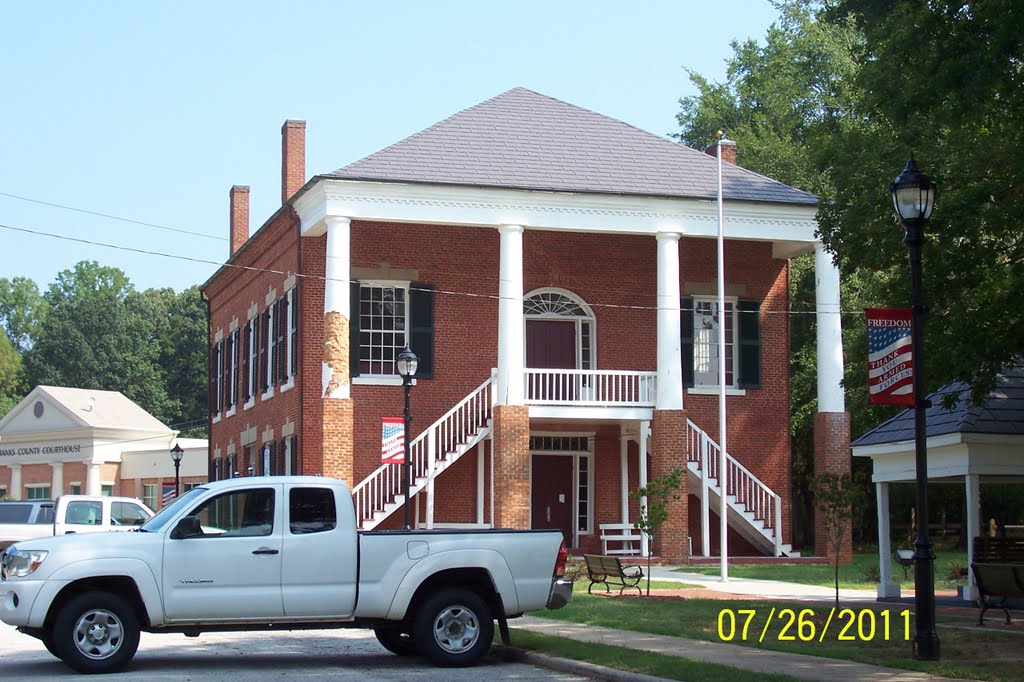|
Old Banks County Courthouse
The Old Banks County Courthouse is in Homer, Georgia. Construction started in 1860 but was interrupted because of the American Civil War. Construction was paid for with $6,600 in Confederate money. Construction was finished in 1875. (''The Georgia Courthouse Manual'' dates it as completed in 1863.) The building is a two-story brick courthouse with a stone foundation in the Greek Revival style. It is similar to many courthouses in Virginia, which is a result of the builders being from Virginia. It has Tuscan columns that are on top of one-story brick piers. The interior originally had a cross plan. The courtroom and judge's chambers are on the second floor, which are accessed by outside double stairways. A new courthouse replaced this one in 1987. There were plans to demolish the building, but the citizens voted by more than a 2:1 margin to save it. It was restored in 1987–1989 with funding through a hotel/motel tax.''The Georgia Courthouse Handbook'' It was added to the N ... [...More Info...] [...Related Items...] OR: [Wikipedia] [Google] [Baidu] |
Calvin Beale
Calvin Lunsford Beale (June 6, 1923 – September 2, 2008) was an American demographer who specialized in rural population trends. He first identified a reverse in population decline in some rural areas, and his work led to development of the Beale code for categorizing rural development. Life and career Born in Washington, D.C., Beale graduated from Eastern High School (Washington, D.C.), Eastern High School and the Wilson Teachers College. After earning a master's degree in sociology from the University of Wisconsin-Madison, University of Wisconsin, he worked at the United States Department of Agriculture for 50 years.Barringer, Felicity (September 2, 2008)Calvin L. Beale, Demographer With a Feel for Rural America, Dies at 85.''The New York Times''Wildman Jim (September 20, 2008)Traveling The Rural Road With Calvin Beale.''National Public Radio'' In addition to his work as a demographer, Beale was noted for his photographs of county courthouses across the United States. Death ... [...More Info...] [...Related Items...] OR: [Wikipedia] [Google] [Baidu] |
Homer, Georgia
Homer is a town in Banks County, Georgia, United States. The population was 1,141 at the 2010 census. The town is the county seat of Banks County. History The community was named after Homer Jackson, a pioneer citizen. Homer was founded in 1858 as seat for the newly established Banks County. Homer was incorporated as a town in 1859, and its first courthouse was built in 1863. Geography Homer is located at (34.333851, -83.499844). According to the United States Census Bureau, the town has a total area of , of which is land and , or 0.38%, is water. Education Banks County students in kindergarten to grade twelve are in the Banks County School District, which consists of two elementary schools, a middle school and a high school. The district has 150 full-time teachers and over 2,428 students. Retrieved May 30, 2010. *Banks ... [...More Info...] [...Related Items...] OR: [Wikipedia] [Google] [Baidu] |
Greek Revival
The Greek Revival was an architectural movement which began in the middle of the 18th century but which particularly flourished in the late 18th and early 19th centuries, predominantly in northern Europe and the United States and Canada, but also in Greece itself following independence in 1832. It revived many aspects of the forms and styles of ancient Greek architecture, in particular the Greek temple, with varying degrees of thoroughness and consistency. A product of Hellenism, it may be looked upon as the last phase in the development of Neoclassical architecture, which had for long mainly drawn from Roman architecture. The term was first used by Charles Robert Cockerell in a lecture he gave as Professor of Architecture to the Royal Academy of Arts, London in 1842. With a newfound access to Greece and Turkey, or initially to the books produced by the few who had visited the sites, archaeologist-architects of the period studied the Doric and Ionic orders. Despite its uni ... [...More Info...] [...Related Items...] OR: [Wikipedia] [Google] [Baidu] |
American Civil War
The American Civil War (April 12, 1861 – May 26, 1865; also known by other names) was a civil war in the United States. It was fought between the Union ("the North") and the Confederacy ("the South"), the latter formed by states that had seceded. The central cause of the war was the dispute over whether slavery would be permitted to expand into the western territories, leading to more slave states, or be prevented from doing so, which was widely believed would place slavery on a course of ultimate extinction. Decades of political controversy over slavery were brought to a head by the victory in the 1860 U.S. presidential election of Abraham Lincoln, who opposed slavery's expansion into the west. An initial seven southern slave states responded to Lincoln's victory by seceding from the United States and, in 1861, forming the Confederacy. The Confederacy seized U.S. forts and other federal assets within their borders. Led by Confederate President Jefferson Davis, ... [...More Info...] [...Related Items...] OR: [Wikipedia] [Google] [Baidu] |
Confederate Money
The Confederate States dollar was first issued just before the outbreak of the American Civil War by the newly formed Confederacy. It was not backed by hard assets, but simply by a promise to pay the bearer after the war, on the prospect of Southern victory and independence. As the Civil War progressed and victory for the South seemed less and less likely, its value declined. After the Confederacy's defeat, its money had no value, and both individuals and banks lost large sums. The first series of Confederate paper money, issued in March 1861, bore interest and had a total circulation of . As the war began to tilt against the Confederates, confidence in the currency diminished, and the government inflated the currency by continuing to print the unbacked banknotes. By the end of 1863, the Confederate dollar (or "Greyback", to distinguish it from the then-new " Greenback" paper US dollar, which was likewise put into circulation during the war) was quoted at just six cents in gold ... [...More Info...] [...Related Items...] OR: [Wikipedia] [Google] [Baidu] |
Virginia
Virginia, officially the Commonwealth of Virginia, is a state in the Mid-Atlantic and Southeastern regions of the United States, between the Atlantic Coast and the Appalachian Mountains. The geography and climate of the Commonwealth are shaped by the Blue Ridge Mountains and the Chesapeake Bay, which provide habitat for much of its flora and fauna. The capital of the Commonwealth is Richmond; Virginia Beach is the most-populous city, and Fairfax County is the most-populous political subdivision. The Commonwealth's population was over 8.65million, with 36% of them living in the Baltimore–Washington metropolitan area. The area's history begins with several indigenous groups, including the Powhatan. In 1607, the London Company established the Colony of Virginia as the first permanent English colony in the New World. Virginia's state nickname, the Old Dominion, is a reference to this status. Slave labor and land acquired from displaced native tribes fueled the ... [...More Info...] [...Related Items...] OR: [Wikipedia] [Google] [Baidu] |
Tuscan Column
The Tuscan order (Latin ''Ordo Tuscanicus'' or ''Ordo Tuscanus'', with the meaning of Etruscan order) is one of the two classical orders developed by the Romans, the other being the composite order. It is influenced by the Doric order, but with un-fluted columns and a simpler entablature with no triglyphs or guttae. While relatively simple columns with round capitals had been part of the vernacular architecture of Italy and much of Europe since at least Etruscan architecture, the Romans did not consider this style to be a distinct architectural order (for example, the Roman architect Vitruvius did not include it alongside his descriptions of the Greek Doric, Ionic, and Corinthian orders). Its classification as a separate formal order is first mentioned in Isidore of Seville's ''Etymologies'' and refined during the Italian Renaissance. Sebastiano Serlio described five orders including a "Tuscan order", "the solidest and least ornate", in his fourth book of ''Regole generali di a ... [...More Info...] [...Related Items...] OR: [Wikipedia] [Google] [Baidu] |
National Register Of Historic Places
The National Register of Historic Places (NRHP) is the United States federal government's official list of districts, sites, buildings, structures and objects deemed worthy of preservation for their historical significance or "great artistic value". A property listed in the National Register, or located within a National Register Historic District, may qualify for tax incentives derived from the total value of expenses incurred in preserving the property. The passage of the National Historic Preservation Act (NHPA) in 1966 established the National Register and the process for adding properties to it. Of the more than one and a half million properties on the National Register, 95,000 are listed individually. The remainder are contributing resources within historic districts. For most of its history, the National Register has been administered by the National Park Service (NPS), an agency within the U.S. Department of the Interior. Its goals are to help property owners and inte ... [...More Info...] [...Related Items...] OR: [Wikipedia] [Google] [Baidu] |
Courthouses On The National Register Of Historic Places In Georgia (U
A courthouse or court house is a building that is home to a local court of law and often the regional county government as well, although this is not the case in some larger cities. The term is common in North America. In most other English-speaking countries, buildings which house courts of law are simply called "courts" or "court buildings". In most of continental Europe and former non-English-speaking European colonies, the equivalent term is a palace of justice ( French: ''palais de justice'', Italian: ''palazzo di giustizia'', Portuguese: ''palácio da justiça''). United States In most counties in the United States, the local trial courts conduct their business in a centrally located courthouse. The courthouse may also house other county government offices, or the courthouse may consist of a designated part of a wider county government building or complex. The courthouse is usually located in the county seat, although large metropolitan counties may have satellite or ... [...More Info...] [...Related Items...] OR: [Wikipedia] [Google] [Baidu] |
National Register Of Historic Places In Banks County, Georgia
This is a list of properties and districts in Banks County, Georgia Banks County is a County (United States), county located in the northeastern part of the U.S. state of Georgia (U.S. state), Georgia. As of the 2020 United States Census, 2020 census, the population was 18,035, down from 18,395 in 2010. The coun ... that are listed on the National Register of Historic Places (NRHP). Current listings References {{Registered Historic Places Banks Banks County, Georgia National Register of Historic Places in Banks County, Georgia ... [...More Info...] [...Related Items...] OR: [Wikipedia] [Google] [Baidu] |
Greek Revival Architecture In Georgia (U
Greek may refer to: Greece Anything of, from, or related to Greece, a country in Southern Europe: *Greeks, an ethnic group. *Greek language, a branch of the Indo-European language family. **Proto-Greek language, the assumed last common ancestor of all known varieties of Greek. **Mycenaean Greek, most ancient attested form of the language (16th to 11th centuries BC). **Ancient Greek, forms of the language used c. 1000–330 BC. **Koine Greek, common form of Greek spoken and written during Classical antiquity. **Medieval Greek or Byzantine Language, language used between the Middle Ages and the Ottoman conquest of Constantinople. **Modern Greek, varieties spoken in the modern era (from 1453 AD). *Greek alphabet, script used to write the Greek language. *Greek Orthodox Church, several Churches of the Eastern Orthodox Church. *Ancient Greece, the ancient civilization before the end of Antiquity. *Old Greek, the language as spoken from Late Antiquity to around 1500 AD. Other uses * '' ... [...More Info...] [...Related Items...] OR: [Wikipedia] [Google] [Baidu] |






